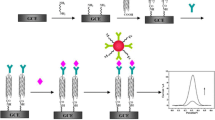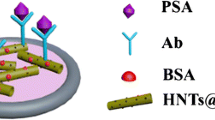Abstract
The authors describe a signal amplification strategy for highly sensitive detection of the prostate-specific antigen (PSA). This is accomplished by a combination of two methods, viz. (a) improved surface-initiated enzymatic polymerization (SIEP), and (b) the use of nanoflowers prepared from C60 fullerene and Methylene Blue (C60/MB) modified with a long single-strand DNA. C60/MB acts as a novel electrochemical indicator. The C60/MB nanoflowers improve the load of MB and promote the electron transfer. The integration of the SIEP technique and the C60/MB nanomaterial also results in improved loading of MB on the nucleic acid. Ultimately, dual cascade signal amplification is accomplished. The biosensor was constructed as follows: (a) Gold nanospheres were modified with antibody 2 (Ab2) and a thiolated oligonucleotide (referred to as S0). (2) S0 is then extended by the SIEP reaction. (3) The redox indicator C60/MB is then connected to the extended guanine-rich ssDNA which then yields the amperometric signal. (4) A sandwich immunoassay is performed by capturing the nanoprobe oy type Ab2-Au-S0 on the gold electrode modified with multi-walled carbon nanotubes (MWCNTs) and protein A. Current is measured by using differential pulse voltammetry (DPV). The synergic effect of the biofunctional nanomaterial and the signal amplification strategy greatly improves the performance of this immunoassay. Under optimized conditions and at a working voltage of typically −0.18 V (vs Ag/AgCl), the assay has a linear range that extends from 15 pg·mL−1 to 8 ng·mL−1 of PSA. The detection limit is as low as 1.7 pg·mL−1 (at an S/N ratio of 3). In our perception, this dual amplification scheme has a wide scope in that it may become applicable to numerous other immunoassays.

C60/Methylene blue nanoflowers, a novel electrochemical indicator, connect with the long single-stranded DNA (ssDNA) extended by the improved surface-initiated enzymatic polymerization method. This amplification strategy is utilized to construct a sandwich prostate-specific antigen (PSA) immunosensor.





Similar content being viewed by others
References
Pezaro C, Woo HH, Davis ID (2014) Prostate cancer: measuring PSA. Intern Med J 44:433–440. https://doi.org/10.1111/imj.12407
Jazayeri MH, Amani H, Pourfatollah AA et al (2016) Enhanced detection sensitivity of prostate-specific antigen via PSA-conjugated gold nanoparticles based on localized surface plasmon resonance: GNP-coated anti-PSA/LSPR as a novel approach for the identification of prostate anomalies. Cancer Gene Ther 23:365–369. https://doi.org/10.1038/cgt.2016.42
Black MH, Giai M, Ponzone R et al (2000) Serum total and free prostate-specific antigen for breast cancer diagnosis in women. Clin Cancer Res 6:467–473
Wang Q, Lin X, Liu Y et al (2015) A scalable framework for mobile video broadcast using MCTF and 2D–DWT. Int. Symp. Wirel. Pers. Multimed. Commun. WPMC. IEEE, In, pp 118–123
Zhang J, Wang S, Gao N et al (2015) Luminescence energy transfer detection of PSA in red region based on Mn2+-enhanced NaYF4:YB, Er upconversion nanorods. Biosens Bioelectron 72:282–287. https://doi.org/10.1016/j.bios.2015.05.024
Spain E, Gilgunn S, Sharma S et al (2016) Detection of prostate specific antigen based on electrocatalytic platinum nanoparticles conjugated to a recombinant scFv antibody. Biosens Bioelectron 77:759–766. https://doi.org/10.1016/j.bios.2015.10.058
Song C, Xie G, Wang L et al (2014) DNA-based hybridization chain reaction for an ultrasensitive cancer marker EBNA-1 electrochemical immunosensor. Biosens Bioelectron 58:68–74. https://doi.org/10.1016/j.bios.2014.02.031
Yang J, Shen H, Zhang X et al (2016) A novel platform for high sensitivity determination of PbP2a based on gold nanoparticles composited graphitized mesoporous carbon and doxorubicin loaded hollow gold nanospheres. Biosens Bioelectron 77:1119–1125. https://doi.org/10.1016/j.bios.2015.11.009
Erdem A, Kerman K, Meric B, Ozsoz M (2001) Methylene blue as a novel electrochemical hybridization indicator. Electroanalysis 13:219–223.
Yang W, Ozsoz M, Hibbert DB, Gooding JJ (2002) Evidence for the direct interaction between methylene blue and guanine bases using DNA-modified carbon paste electrodes. Electroanalysis 14:1299–1302. https://doi.org/10.1016/S1388-2481(02)00428-9
Tjong V, Yu H, Hucknall A et al (2011) Amplified on-chip fluorescence detection of DNA hybridization by surface-initiated enzymatic polymerization. Anal Chem 83:5153–5159. https://doi.org/10.1021/ac200946t
Wang P, Wan Y, Deng S et al (2016) Aptamer-initiated on-particle template-independent enzymatic polymerization (aptamer-OTEP) for electrochemical analysis of tumor biomarkers. Biosens Bioelectron 86:536–541. https://doi.org/10.1016/j.bios.2016.07.025
Lawrence JR, Waiser MJ, Swerhone GDW et al (2016) Effects of fullerene (C60), multi-wall carbon nanotubes (MWCNT), single wall carbon nanotubes (SWCNT) and hydroxyl and carboxyl modified single wall carbon nanotubes on riverine microbial communities. Environ Sci Pollut Res 23:10090–10102. https://doi.org/10.1007/s11356-016-6244-x
Roushani M, Bakyas K, Zare Dizajdizi B (2016) Development of sensitive amperometric hydrogen peroxide sensor using a CuNPs/MB/MWCNT-C60-Cs-IL nanocomposite modified glassy carbon electrode. Mater Sci Eng C 64:54–60. https://doi.org/10.1016/j.msec.2016.03.078
Buchelnikov AS, Kostyukov VV, Yevstigneev MP, Prylutskyy YI (2013) Mechanism of complexation of the phenothiazine dye methylene blue with fullerene C60. Russ J Phys Chem A 87:662–667. https://doi.org/10.1134/S0036024413040067
Evstigneev MP, Buchelnikov AS, Voronin DP et al (2013) Complexation of C60 fullerene with aromatic drugs. Chem Phys Chem 14:568–578. https://doi.org/10.1002/cphc.201200938
Tolkachov M, Sokolova V, Loza K et al (2016) Study of biocompatibility effect of nanocarbon particles on various cell types in vitro. Materwiss Werksttech 47:216–221. https://doi.org/10.1002/mawe.201600486
Panchuk RR, Prylutska SV, Chumak VV et al (2015) Application of C60 fullerene-doxorubicin complex for tumor cell treatment in vitro and in vivo. J Biomed Nanotechnol 11:1139–1152. https://doi.org/10.1166/jbn.2015.2058
Prylutskyy Y, Bychko A, Sokolova V et al (2016) Interaction of C60 fullerene complexed to doxorubicin with model bilipid membranes and its uptake by HeLa cells. Mater Sci Eng C 59:398–403. https://doi.org/10.1016/j.msec.2015.10.049
Wang H, Bai L, Chai Y, Yuan R (2014) Synthesis of multi-fullerenes encapsulated palladium nanocage, and its application in electrochemiluminescence immunosensors for the detection of streptococcus suis serotype 2. Small 10:1857–1865. https://doi.org/10.1002/smll.201303594
Han J, Zhuo Y, Chai YQ et al (2015) New type of redox nanoprobe: C60-based nanomaterial and its application in electrochemical immunoassay for doping detection. Anal Chem 87:1669–1675. https://doi.org/10.1021/ac503406p
Tsai W-C, Pai P-JR (2009) Surface plasmon resonance-based immunosensor with oriented immobilized antibody fragments on a mixed self-assembled monolayer for the determination of staphylococcal enterotoxin B. Microchim Acta 166:115–122. https://doi.org/10.1007/s00604-009-0171-1
Lin D, Mei C, Liu A et al (2015) Cascade signal amplification for electrochemical immunosensing by integrating biobarcode probes, surface-initiated enzymatic polymerization and silver nanoparticle deposition. Biosens Bioelectron 66:177–183. https://doi.org/10.1016/j.bios.2014.10.074
Zhao M, Zhuo Y, Chai YQ, Yuan R (2015) Au nanoparticles decorated C60 nanoparticle-based label-free electrochemiluminesence aptasensor via a novel “on-off-on” switch system. Biomaterials 52:476–483. https://doi.org/10.1016/j.biomaterials.2015.02.058
Diaconu M, Litescu SC, Radu GL (2010) Laccase-MWCNT-chitosan biosensor-a new tool for total polyphenolic content evaluation from in vitro cultivated plants. Sensors Actuators B Chem 145:800–806. https://doi.org/10.1016/j.snb.2010.01.064
Wang Z, Dai Z (2015) Carbon nanomaterial-based electrochemical biosensors: an overview. Nano 7:6420–6431. https://doi.org/10.1039/C5NR00585J
Xie Q, Perez-Cordero E, Echegoyen L (1992) Electrochemical detection of C606- and C706-: enhanced stability of fullerides in solution. J Am Chem Soc 114:3978–3980. https://doi.org/10.1021/ja00036a056
Shiraishi H, Itoh T, Hayashi H et al (2007) Electrochemical detection of E. Coli 16S rDNA sequence using air-plasma-activated fullerene-impregnated screen printed electrodes. Bioelectrochemistry 70:481–487. https://doi.org/10.1016/j.bioelechem.2006.07.011
Lee SW, Hosokawa K, Kim S et al (2016) Porous silicon microarray for simultaneous fluorometric immunoassay of the biomarkers prostate-specific antigen and human glandular kallikrein 2. Microchim Acta 183:3321–3327. https://doi.org/10.1007/s00604-016-1986-1
Xu S, Liu Y, Wang T, Li J (2011) Positive potential operation of a cathodic Electrogenerated Chemiluminescence Immunosensor based on Luminol and graphene for cancer biomarker detection. Anal Chem 83:3817–3823. https://doi.org/10.1021/ac200237j
Salimi A, Kavosi B, Fathi F, Hallaj R (2013) Highly sensitive immunosensing of prostate-specific antigen based on ionic liquid–carbon nanotubes modified electrode: application as cancer biomarker for prostatebiopsies. Biosens Bioelectron 42:439–446. https://doi.org/10.1016/j.bios.2012.10.053
Jang HD, Kim SK, Chang H, Choi J-W (2015) 3D label-free prostate specific antigen (PSA) immunosensor based on graphene–gold composites. Biosens Bioelectron 63:546–551. https://doi.org/10.1016/j.bios.2014.08.008
Mao K, Wu D, Li Y et al (2012) Label-free electrochemical immunosensor based on graphene/methylene blue nanocomposite. Anal Biochem 422:22–27. https://doi.org/10.1016/j.ab.2011.12.047
Acknowledgments
This work was financially supported by the Chongqing Municipal Education Commission science and technology research project Foundation of China (KJ1400211).
Author information
Authors and Affiliations
Corresponding author
Ethics declarations
The author(s) declare that they have no competing interests.
Eletronic supplementary material
ESM 1
(DOCX 2659 kb)
Rights and permissions
About this article
Cite this article
Hao, Y., Yan, P., Zhang, X. et al. Ultrasensitive amperometric determination of PSA based on a signal amplification strategy using nanoflowers composed of single-strand DNA modified fullerene and Methylene Blue, and an improved surface-initiated enzymatic polymerization. Microchim Acta 184, 4341–4349 (2017). https://doi.org/10.1007/s00604-017-2476-9
Received:
Accepted:
Published:
Issue Date:
DOI: https://doi.org/10.1007/s00604-017-2476-9




